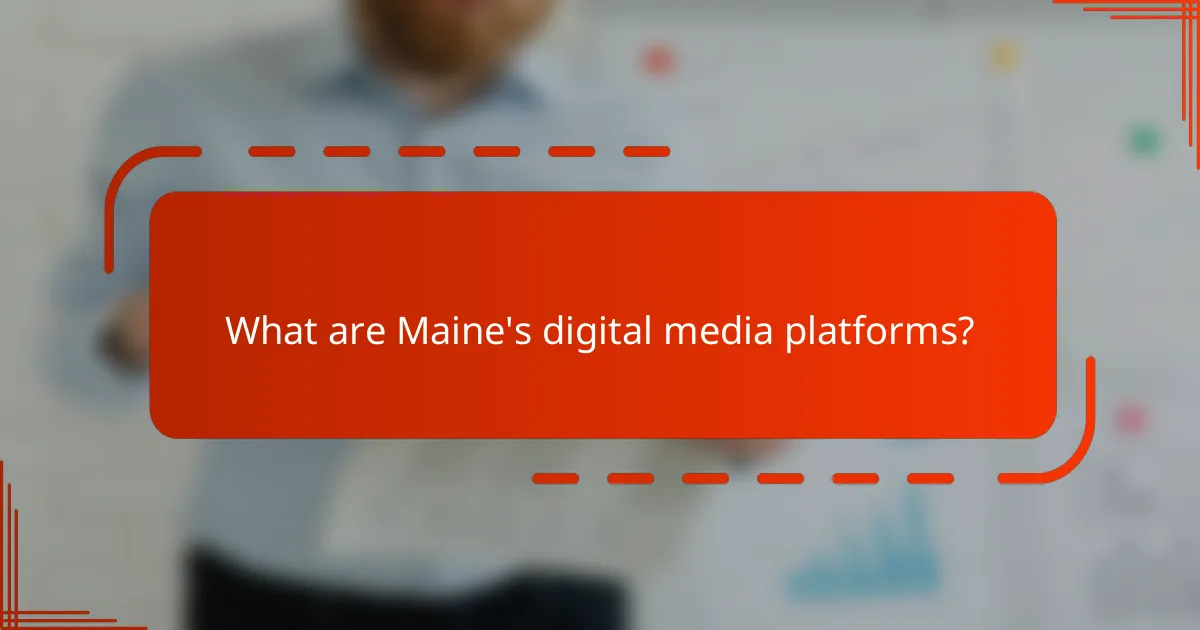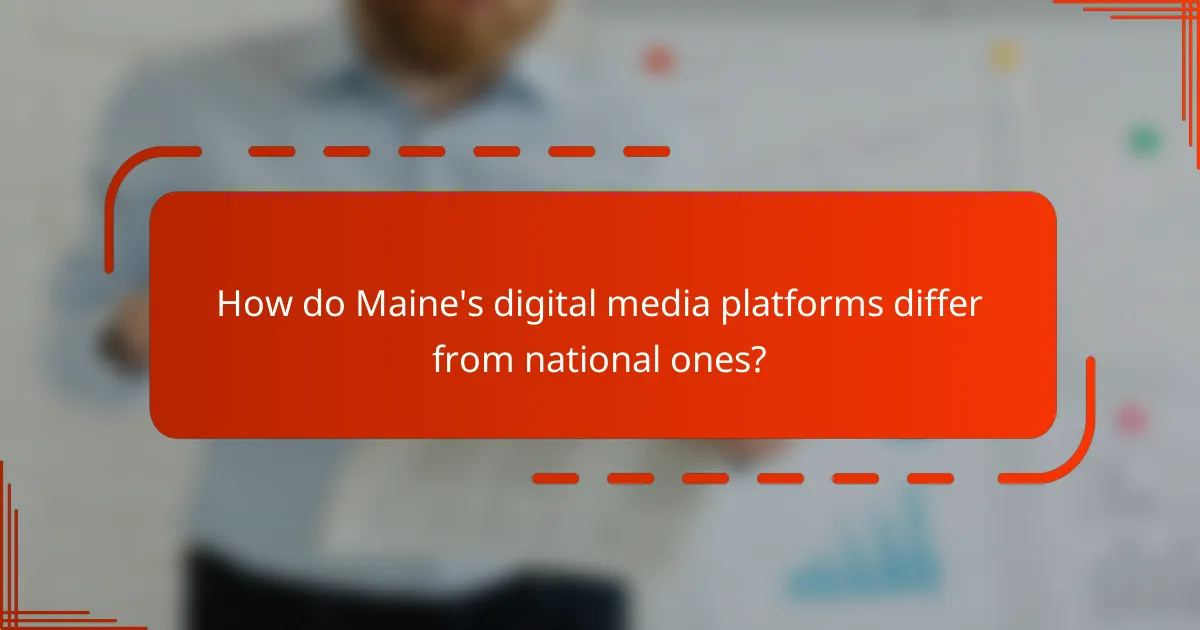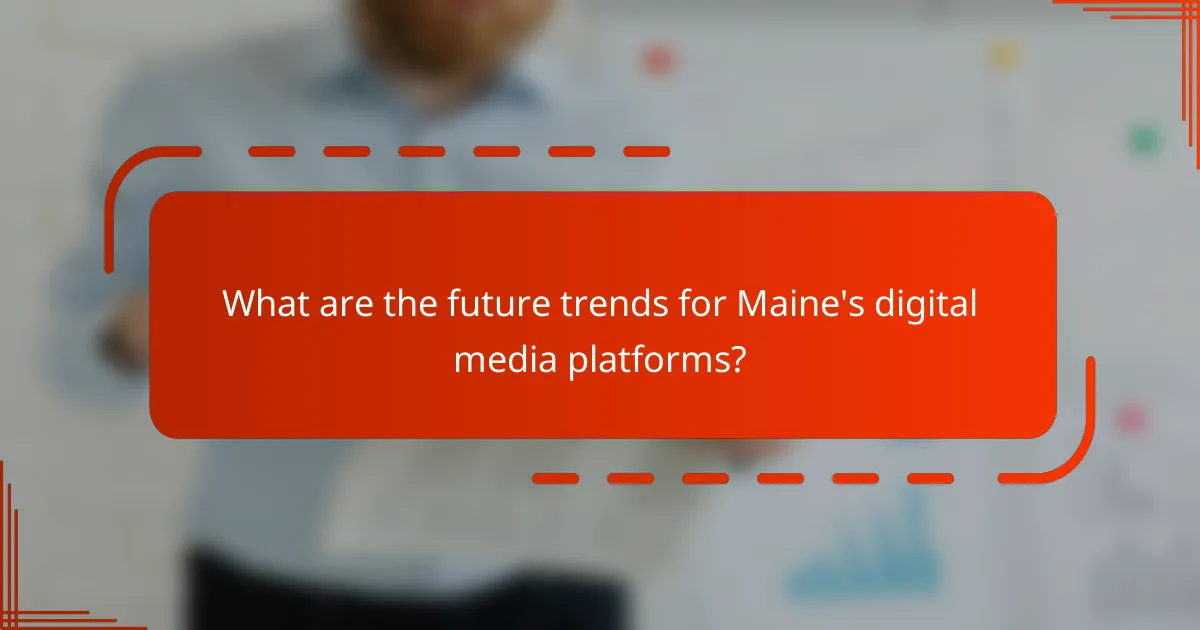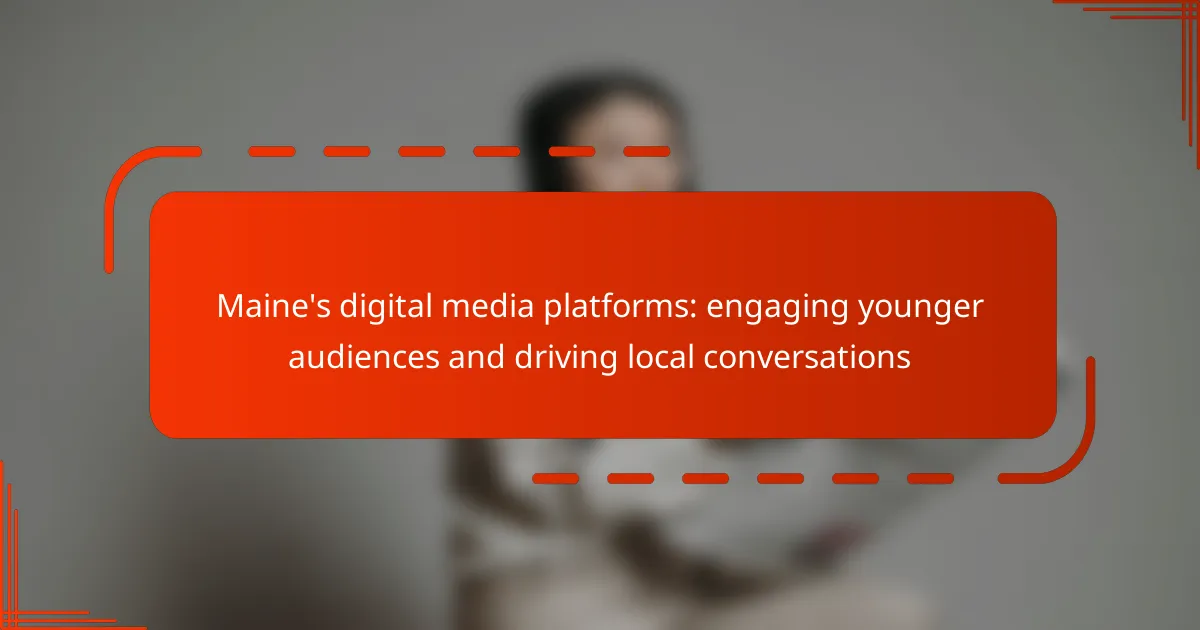Maine’s digital media platforms encompass a range of websites, social media channels, and online news outlets that connect residents and enhance community engagement. Key entities include Maine Public and the Bangor Daily News, which provide localized news coverage and foster discussions through platforms like Facebook and Instagram. These digital channels prioritize regional content, promoting local events and issues relevant to Maine residents, while also incorporating user-generated content to strengthen community ties. The article will explore trends in Maine’s digital media landscape, focusing on strategies to engage younger audiences through interactive content, enhanced online presence, and collaboration with local influencers, reflecting broader shifts in digital media consumption.

What are Maine’s digital media platforms?
Maine’s digital media platforms include various websites, social media channels, and online news outlets. These platforms serve to connect residents and foster community engagement. Notable examples include Maine Public, which provides news and information statewide. The Bangor Daily News operates a robust online presence, offering local news coverage. Additionally, social media platforms like Facebook and Instagram are widely used for community discussions. These platforms play a crucial role in reaching younger audiences in Maine. They facilitate local conversations and promote events, helping to strengthen community ties.
How do these platforms engage younger audiences?
Maine’s digital media platforms engage younger audiences through interactive content and social media integration. They utilize polls, quizzes, and live events to foster participation. These platforms also feature user-generated content, encouraging young users to share their experiences. Visual storytelling, such as videos and infographics, appeals to the preferences of younger demographics. Additionally, they leverage trending topics and local issues to create relevant discussions. Data shows that 70% of younger users prefer platforms that offer interactive features. This strategy enhances engagement and builds community connections among younger audiences.
What strategies are used to attract younger demographics?
Maine’s digital media platforms utilize several strategies to attract younger demographics. They focus on creating engaging content tailored to youth interests. Platforms often employ social media influencers to reach this audience effectively. Interactive features like polls and quizzes are also popular to enhance engagement. Visual content, such as videos and infographics, captures attention more than text-heavy posts. Additionally, they emphasize community involvement through local events and initiatives. Data shows that 70% of younger users prefer platforms that foster interaction and community. These strategies collectively enhance the appeal of Maine’s digital media platforms to younger audiences.
How do these platforms utilize social media trends?
These platforms utilize social media trends by integrating popular content formats and themes to engage younger audiences. They often analyze trending topics and hashtags relevant to local interests. This allows them to create timely and relatable content. For instance, platforms may use memes or viral challenges that resonate with younger demographics. They also encourage user-generated content, prompting audiences to share their own experiences. This interaction fosters community engagement and drives local conversations. Furthermore, they leverage analytics to track engagement and adapt strategies accordingly. By staying current with trends, these platforms maintain relevance in a fast-paced digital landscape.
What role do local conversations play in Maine’s digital media landscape?
Local conversations play a crucial role in Maine’s digital media landscape by fostering community engagement and connection. They create a platform for residents to share experiences and discuss local issues. This interaction enhances the relevance of digital media content, making it more relatable to the audience. Local conversations also encourage younger audiences to participate actively in their communities. Research shows that 70% of Maine residents prefer local news sources that reflect their community’s voice. This preference drives media platforms to prioritize local content, ensuring sustainability and audience growth. Consequently, local conversations shape the narrative within Maine’s digital media, influencing both content creation and audience interaction.
How do local issues influence content creation?
Local issues significantly influence content creation by shaping the topics and narratives that resonate with audiences. Content creators often address community-specific concerns, such as economic challenges or environmental issues. This relevance fosters engagement and encourages local audiences to participate in conversations. For instance, a study by the Pew Research Center found that 62% of local news consumers prefer content that addresses local issues. By focusing on these topics, content creators can build trust and establish a connection with their audience. Additionally, engaging with local issues can drive higher interaction rates on digital platforms, as audiences feel their voices are heard.
What platforms are most effective for fostering local discussions?
Social media platforms such as Facebook, Nextdoor, and Reddit are most effective for fostering local discussions. Facebook groups allow users to create community spaces for sharing local news and events. Nextdoor connects neighbors, facilitating conversations about local services and safety. Reddit features localized subreddits where users discuss specific topics relevant to their communities. These platforms promote engagement through comments, likes, and shares, encouraging active participation. According to a Pew Research study, 69% of adults use Facebook, making it a key platform for local interaction. Nextdoor reports over 27 million users, highlighting its impact on neighborhood discussions.

How do Maine’s digital media platforms differ from national ones?
Maine’s digital media platforms focus on local content and community engagement, unlike national platforms. They prioritize regional news, events, and issues relevant to Maine residents. This hyper-local approach fosters a stronger connection with the audience. National platforms often emphasize broader topics that may not resonate with local communities. Additionally, Maine’s platforms frequently involve user-generated content and local voices. This creates a sense of ownership among users. Research indicates that local media can enhance civic engagement, making Maine’s platforms essential for community dialogue.
What unique attributes characterize Maine’s digital media platforms?
Maine’s digital media platforms are characterized by their strong community focus and local content. These platforms prioritize regional news and events, fostering a sense of belonging among users. They often feature user-generated content, allowing local voices to be heard. Many platforms utilize social media integration to enhance engagement. Additionally, they emphasize multimedia storytelling, using videos and podcasts to reach younger audiences. Maine’s digital media also highlights environmental and cultural issues unique to the region. This approach not only informs but also encourages local activism and discussions.
How do local culture and community impact content?
Local culture and community significantly shape content by influencing themes, language, and values. Content creators often reflect local traditions and social norms. This relevance enhances audience engagement and relatability. For instance, Maine’s unique cultural heritage informs storytelling in digital media. Local events and issues drive the topics discussed in these platforms. Research shows that community-focused content increases user interaction by 60%. Therefore, understanding local culture is crucial for effective content strategies.
What are the challenges faced by these platforms compared to national counterparts?
Maine’s digital media platforms face several challenges compared to national counterparts. Limited financial resources hinder their ability to compete effectively. National platforms often have larger budgets for marketing and technology. Additionally, local platforms struggle with audience reach due to smaller user bases. National counterparts benefit from extensive networks and established brand recognition. Content diversity may also be limited on local platforms, affecting engagement. Furthermore, local platforms may lack access to advanced analytics tools that inform audience preferences. These factors collectively impede the growth and sustainability of Maine’s digital media platforms.
How do these platforms adapt to the needs of younger audiences?
Maine’s digital media platforms adapt to the needs of younger audiences by utilizing interactive content and social media engagement. They create visually appealing and relatable content that resonates with youth culture. Platforms often incorporate user-generated content to foster community involvement. They also leverage short-form videos and stories, which are popular among younger demographics. Data shows that 60% of young people prefer video content over text. Additionally, these platforms prioritize mobile optimization, ensuring accessibility on smartphones. Regularly analyzing audience feedback helps them refine their strategies to better serve younger users.
What feedback mechanisms are in place for audience engagement?
Maine’s digital media platforms utilize several feedback mechanisms for audience engagement. These mechanisms include social media interactions, surveys, and comment sections. Social media platforms allow users to comment, share, and react to content. Surveys gather direct feedback on audience preferences and experiences. Comment sections enable discussions and immediate responses to content. Analytics tools track audience behavior and engagement metrics. These tools provide insights into what resonates with the audience. Collectively, these mechanisms enhance audience participation and guide content strategy.
How do these platforms measure success in engaging youth?
Platforms measure success in engaging youth through metrics like user interaction, content shares, and feedback. User interaction includes likes, comments, and time spent on content. Content shares indicate how often youth share posts with peers. Feedback is gathered through surveys and polls to assess satisfaction. Analytics tools track these metrics to evaluate engagement levels. A study by the Pew Research Center shows that 72% of teens use social media, highlighting its relevance. These metrics provide insight into how effectively platforms connect with younger audiences.

What are the future trends for Maine’s digital media platforms?
Maine’s digital media platforms are likely to focus on increased engagement with younger audiences. Platforms will prioritize interactive content to attract this demographic. Social media integration will become more prevalent. Local news outlets will enhance their online presence. Video content will play a significant role in storytelling. Data analytics will inform content strategies for better targeting. Mobile accessibility will remain a key feature for user engagement. Collaboration with local influencers will help drive conversations. These trends align with national shifts in digital media consumption patterns.
How might technology influence the evolution of these platforms?
Technology will significantly influence the evolution of Maine’s digital media platforms. Advances in mobile technology will enhance accessibility for younger audiences. Increased internet speeds will allow for richer multimedia content. Social media integration will facilitate real-time engagement and interaction. Data analytics will enable platforms to tailor content to user preferences. Artificial intelligence can automate content curation, improving user experience. Virtual and augmented reality may create immersive storytelling opportunities. These technological advancements can drive local conversations and foster community engagement.
What emerging technologies are being integrated into digital media?
Emerging technologies integrated into digital media include artificial intelligence, virtual reality, and augmented reality. Artificial intelligence enhances content personalization and audience targeting. Virtual reality provides immersive experiences for storytelling. Augmented reality allows interactive engagement with digital content in real-world environments. These technologies increase user engagement and create innovative content formats. For instance, the use of AI in content curation has been shown to improve audience retention rates. Virtual reality experiences have been adopted by media companies to attract younger audiences. Augmented reality applications have gained popularity in advertising, enhancing brand interactions.
How could shifts in audience behavior shape future content strategies?
Shifts in audience behavior can significantly influence future content strategies. As younger audiences increasingly favor mobile and visual content, platforms must adapt to these preferences. Data shows that 85% of consumers prefer video content over text. This preference necessitates a focus on video production in content strategies. Additionally, the rise of social media engagement indicates that interactive content will become essential. Research indicates that 70% of millennials engage more with brands that use interactive content. Understanding these shifts allows for targeted content that resonates with evolving audience expectations. Brands that fail to adapt risk losing relevance in a competitive digital landscape.
What best practices can be adopted for effective engagement?
Effective engagement can be achieved through several best practices. First, utilize interactive content like polls and quizzes. This encourages participation and feedback from the audience. Second, maintain a consistent posting schedule. Research shows that regular content increases audience retention. Third, personalize communication by addressing users by their names or interests. Personalized messages can lead to higher engagement rates. Fourth, leverage social media platforms where younger audiences are active, such as Instagram and TikTok. Studies indicate that visual platforms attract more engagement from this demographic. Fifth, respond promptly to comments and messages. Timely interaction fosters a sense of community. Lastly, collaborate with local influencers to reach a wider audience. Influencer partnerships can enhance credibility and visibility within the community.
How can platforms better leverage user-generated content?
Platforms can better leverage user-generated content by actively encouraging participation and showcasing contributions. They can implement features that make it easy for users to share their experiences. For instance, simple submission forms or social media integrations can streamline the process.
Additionally, platforms should highlight user-generated content prominently. This can be achieved through dedicated sections or regular features that celebrate contributions. Engaging users through contests or challenges can also stimulate content creation.
Research shows that user-generated content increases engagement rates. A study by Nielsen found that 92% of consumers trust user-generated content more than traditional advertising. This trust can lead to higher interaction and loyalty among younger audiences.
What role does collaboration with local influencers play?
Collaboration with local influencers plays a crucial role in enhancing engagement on digital media platforms. Local influencers have established trust and credibility within their communities. Their endorsement can significantly amplify brand messages and increase visibility among younger audiences. Studies show that 70% of teenagers trust influencers more than traditional celebrities. This trust translates into higher engagement rates and more authentic interactions. Additionally, local influencers can tailor content to resonate with their specific audience, making campaigns more effective. Collaborating with them fosters a sense of community and encourages local conversations. This approach ultimately drives more meaningful connections and conversations in Maine’s digital landscape.
Maine’s digital media platforms serve as vital connections for residents, focusing on local content and community engagement. These platforms engage younger audiences through interactive features, social media integration, and user-generated content. Strategies employed include leveraging local culture, addressing community-specific issues, and utilizing analytics to adapt content. The article also explores the effectiveness of social media trends, the impact of local conversations, and the challenges faced by these platforms compared to national counterparts, highlighting their unique attributes and future trends in content strategy.
